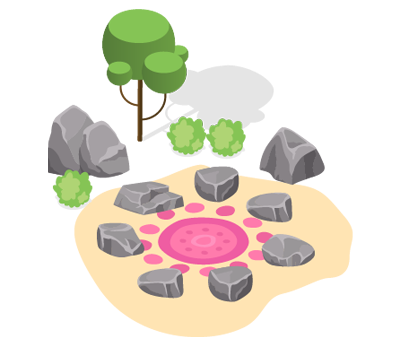The Good Village
Yarning Circle
Developed in partnership with Tracy Hardy and with feedback from Reconciliation Australia’s Narragunnawali team.
Acknowledgment of Country
The Good Village acknowledges the Traditional Custodians of country throughout Australia and their connections to land, sea and community. We pay our respects to their Elders past, present and emerging, and extend that respect to all Aboriginal and Torres Strait Islander peoples using the resource.
What is a Yarning Circle?
Welcome to the Yarning Circle. Yarning is about building respectful relationships with friends, family and strangers. Aboriginal and Torres Strait Islander peoples have used Yarning Circles for thousands of years to communicate respectfully in a safe space, resolve conflicts, negotiate trade routes and welcome visitors.
When did Aboriginal and Torres Strait Islanders begin using Yarning circles?
Because Aboriginal and Torres Strait Islander culture goes back as far as 65,000 years, we are unable to know for sure when Yarning Circles began.
What we do know is that Yarning is a deeply meaningful and important part of Aboriginal culture, and has been practised for thousands of years. To this day, Aboriginal and Torres Strait Islander communities continue to come together to talk, share, and educate one another through the sharing of stories and passing of cultural knowledge.
Are non-indigenous people allowed to form a Yarning circle?
Many Aboriginal and Torres Strait Islander people encourage the sharing of non-indigenous and Indigenous culture, and Yarning is considered a meaningful method of navigating this. Because Yarning Circles encourage listening, transparency, and community togetherness, Yarning is a great way for non-indigenous individuals to learn more about the issues and values of Aboriginal and Torres Strait Islanders in their community. Outside of learning about Aboriginal culture and values, Yarning Circles are becoming more commonly used in Primary School and Early Childhood settings to teach better communication and listening skills.
How can Yarning circles be used in schools?
Yarning Circles are a great way to educate young people on traditional Aboriginal and Torres Strait Islander practices as well as creating a space for sharing, conflict resolution and collaboration.
A good way to introduce yarning into the classroom is by electing a regular time (every Thursday afternoon, for example) and choosing a dedicated space away from the learning area (such as a breakout space). Once you have chosen a time and comfortable space for your Yarning Circle, invite all children to sit in a way that’s comfortable to them. Then, allow each child 1-2 minutes to share something that’s on their mind – either something they’re struggling with, something they're excited about or something they want to understand more about.
Although there shouldn’t be too much structure in a time of Yarning, be sure to emphasise the importance of listening to one another in the circle. Make sure that children know that everyone will eventually get their chance to share and respond to one another as part of the Yarning Circle.
Check out these activities from our Games Room, which will help to grow students' empathy and communication skills.
Some of the benefits of introducing a Yarning Circle in classroom include:
- deepening connection with Aboriginal and Torres Strait Islander culture and practice
- teaching students the art of listening and speaking from the heart
- encouraging honest and deeper conversation
- highlighting opportunities and methods for problem solving
- teaching and growing empathy skills
What is needed to hold a Yarning Circle?
One of the great qualities about Yarning Circles is their accessible nature. Yarning Circles do not require special equipment, however, the following items will help in developing your space for Yarning.
- A space that can comfortably fit all students in a circle formation
- Throw cushions, blankets, chairs and other items that will enhance comfort for students
- A small object (like a shell or stone) that can be passed around to circle to indicate who’s turn it is to speak
Further Yarning Circle ideas and educational resources
Learn more about Yarning and Yarning Circles by clicking these links:


